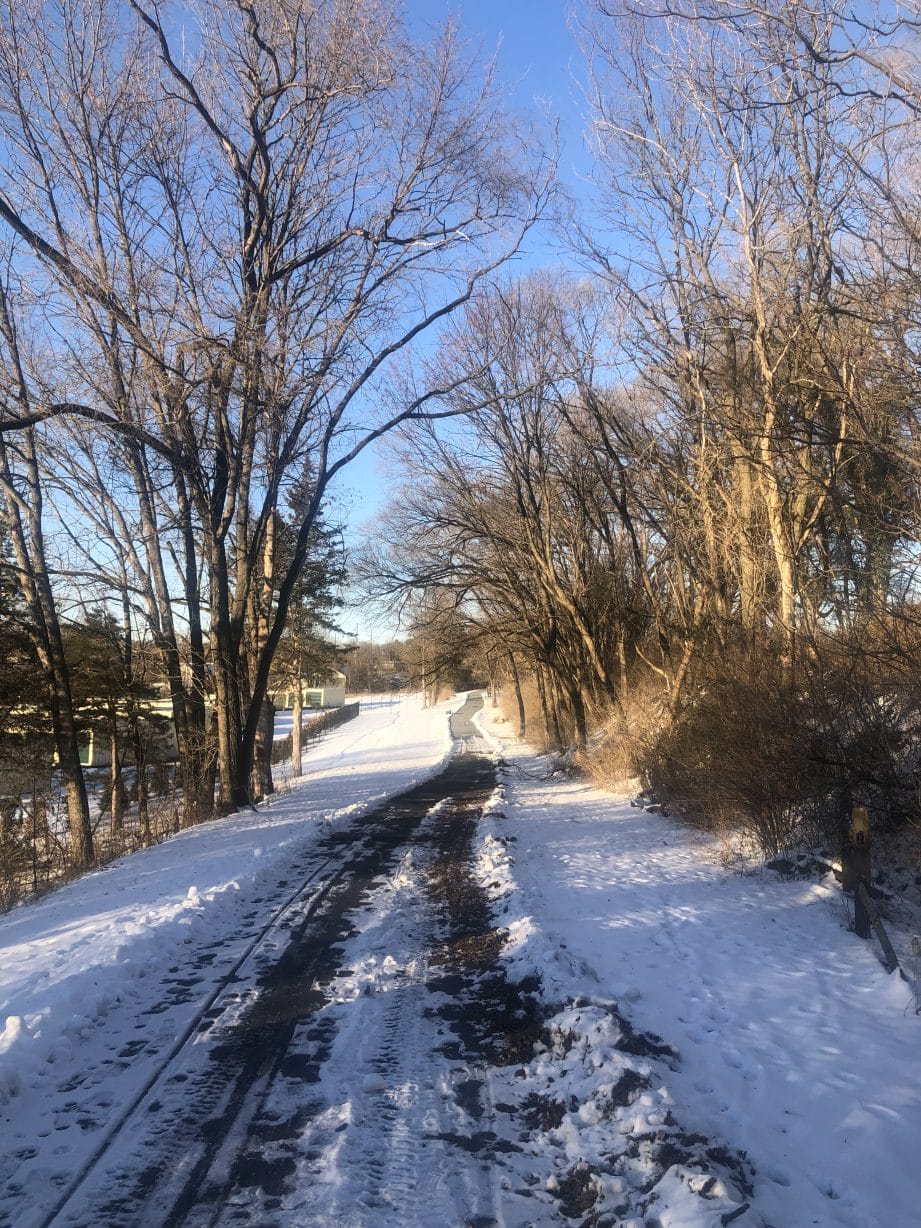
By Sofia Samatar
“The Friendly City” is a weekly column about walking in Harrisonburg that will run during 2024. Each week, your friendly correspondent, writer and teacher Sofia Samatar, will reflect on a walk in our city.
Extreme brightness of January sun. Is it possible to walk off sorrow? Thick ice coats the edges of the streets, drawing the light toward it, playing with it and throwing it back to the cold blue sky where a patch of moon is stamped like a thumbprint of chalk. A walk can feel so arbitrary and useless. It’s an activity that could easily be skipped, exchanged for something more productive, some practical confrontation with a source of despair, whether personal, communal, or global.
My stroll is gratuitous, extra, like one of my favorite spots in town, the little bike path I’m entering now: a brief stretch of pavement, laughably short, a mere whisker of a sidetrack, which takes me about a minute to walk. What is the point of this path? Who decided it was essential for cyclists to cut through this strip of scrub behind Family Dollar? I imagine a whimsical city planner, or one who’d had too much coffee. To enter the bike path, you pass the mechanic, where people are often working outside, but not today: the cold has driven everyone indoors, and the only sign of life in the mechanic’s shop is a thin trail of smoke seeping up from the roof. Tires are piled in the yard, sagging cars, a child’s scooter, all covered with snow. A simple two-railed fence separates the shop from the path, a rustic barrier of rough, greenish wood that suggests you’ve wandered into a country lane, or even a different era.
This fence reminds me of my morning reading: a newspaper from the Friendly City one hundred years ago. I’d learned from my friend the historian that the city’s old papers had been digitized, so I opened an online archive for a glimpse of January 1924. Scanned pages filled my laptop screen, modern in form yet timeworn in quality, the text sometimes blackened into illegibility, the salvaged articles and advertisements rising out of the damaged print like flotsam on a dark stream.
In 1924, I read, the hog market was growing. A local veterinarian issued a plea for dairies to improve sanitation. In Washington, President Coolidge caused a stir by visiting a Black neighborhood to call on the ailing Arthur Brooks, “valet to presidents” since the Taft administration. Five day-trippers from Staunton narrowly escaped tragedy when their car tumbled over a culvert. Two professors at William and Mary were arrested for duck-hunting after dark. A resident of the Friendly City placed a hopeful ad for the return of a box of Brown’s Mule Tobacco, mislaid downtown on Saturday night.
I’m walking up the bike path, the trees on my left closing off the city, the sound of traffic fading. On my right, the trees have been cut down, and it gives me a pang to remember them, for once they turned this corner of town into a secret forest. Now that side of the bike path has been torn open, revealing rectangular rows of storage units with green metal doors. Cars pass on the road beyond. There’s no longer a sense of being secluded from the world for the length of a breath. The thickets are gone, where I used to see deer, where tents were pitched in the shade. But a row of pines has been planted along the storage units, so I have hope that something like the old greenwood will come back. And the house at the end of the path, with its little windows and steeply slanted roof, still encourages dreams, making me wonder what it’s like to live in this odd, quiet nook, enclosed in this sun-streaked hush.
When I turn and look back along the path, my heart lifts. For an instant, despite the lost trees, I see an enchanted corridor receding into mystery. The city has disappeared. This isn’t a bike path, it’s not a road, it’s the road, the one the child takes in the fairy tale, toward adventure.
A fleeting illusion. Inessential, extra. A scrap of ribbon tied to the city.
I leave the path and walk up the street. Here are some items for sale in a yard: gas cans, a tire, a mover’s dolly. I think of the 1924 auction I read about this morning, in which two cows and two steers would be sold, along with a hundred chickens, a 1918 model Ford touring car, three tons of coal, and a dinner bell. Reading the list, I felt as if I was there, crossing the yard where the Ford stood parked by the woodpile, walking through the house. “Very old library table, in excellent condition; ‘secretary’ or desk and book-case combined, 100 years old or more; walnut chest, new cedar chest, lot of chairs, rockers, beds, carpets, linoleum . . .” I saw the antique sewing machine, the parlor organ, and the Silvertone phonograph with “a choice lot of records.” But I was most moved by the little things, as the list began to trail off, as if the house were running out of ways to prove its worth. “Meat tub, vinegar barrel, canned fruit, empty cans, jellies, preserves, honey, etc. . . . and many other things too numerous to mention.”
No, it’s not possible to walk off sorrow. Your walk is not a cure. It’s just one of the numerous things.
I pass a yard where a pinwheel casts a spinning shadow on the snow. Farther on, a terracotta figure prays inside a shell. There’s a mirror propped on a porch to catch the light. A plaster gargoyle. So many plant pots. These little touches. A green glass bird.












